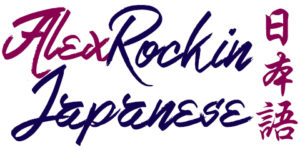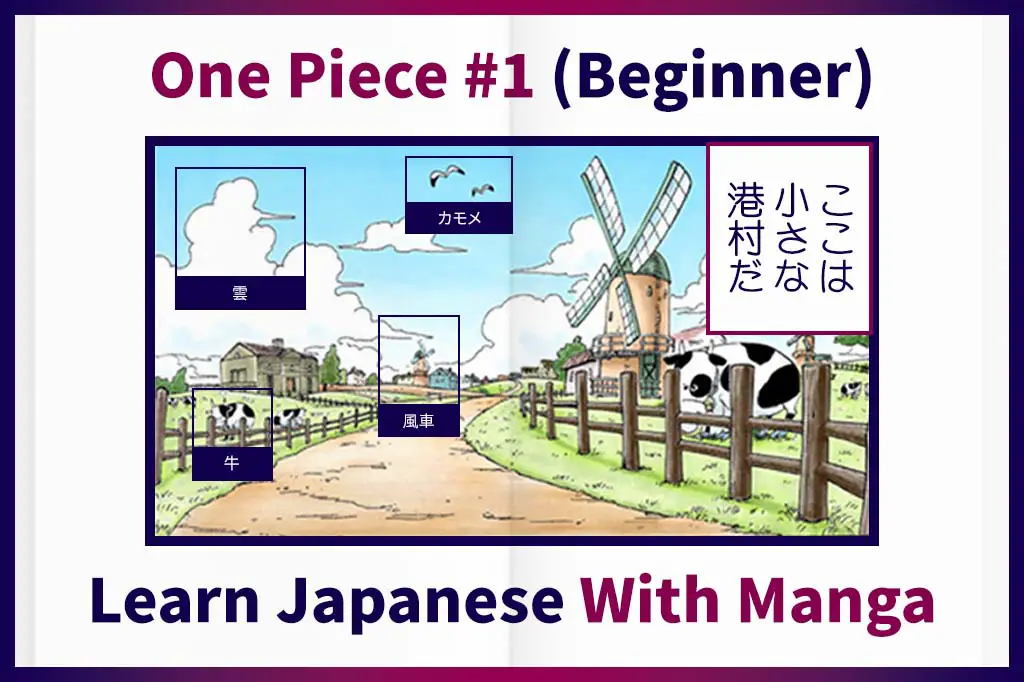Welcome to the dawn of your adventure in learning Japanese with manga! In this beginner-friendly lesson, we’ll dive into the first chapter of One Piece. You’ll not only experience the fun and excitement of reading your favorite manga in Japanese, but also learn practical Japanese along the way.
Through an original example from the One Piece manga series, we’ll explore words, phrases, and sentence structures to deepen your understanding of the Japanese language. By the end of this lesson, you’ll be able to read the following Japanese sentences – and hopefully even start creating your own!
- 港村だ。
- 小さな港村だ。
- ここは小さな港村だ。
Learn Japanese With Manga: One Piece #1 (Beginner)

- Manga: One Piece (ワンピース)
- Part: Vol. 1 (巻一), Chapter 1 (第1話)
- Japanese Title: Romance Dawnー冒険の夜明けー
- Title in English: Romance Dawn -The Dawn of Adventure-
1. Read One Piece Manga in Japanese
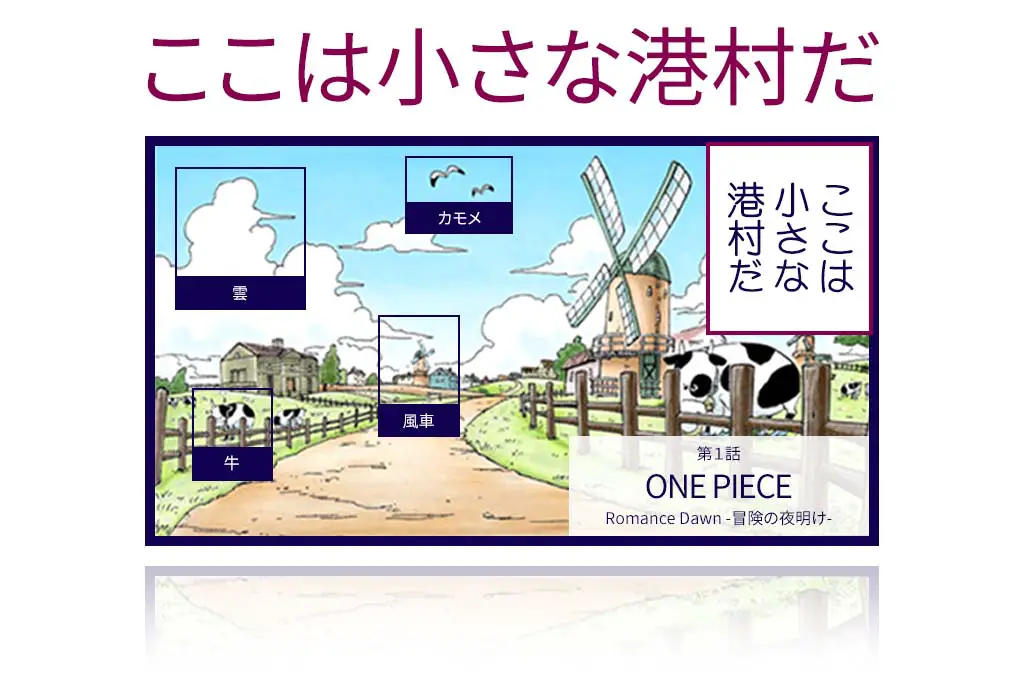
In this manga panel from the first chapter of One Piece, the narrator introduces us to the idyllic place where the story of One Piece and Luffy’s pirate adventure starts.
| ここは小さな港村だ |
Kanji & Kana
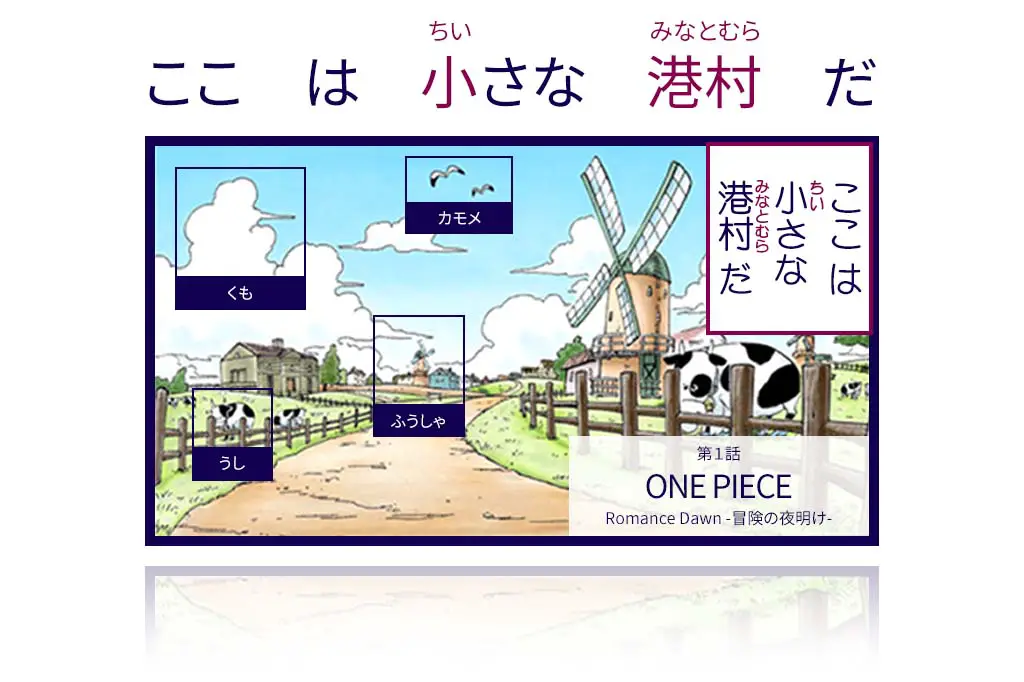
| Kanji | ここ は 小さな 港村 だ |
| Kana | ここ は ちいさな みなとむら だ |
- 小さ: ちいさ
- 港: みなと
- 村: むら
Romaji
check if necessary
ここ は ちいさ な みなとむら だ
Koko ha (wa) chiisa na minato mura da
- こ: ko
- は: ha
- ち: chi
- い: i
- さ: sa
- な: na
- み: mi
- と: to
- む: mu
- ら: ra
- だ: da
English Translation
| Japanese | ここ は 小さな 港村 だ |
| English | Here is a small harbor village. |
| Literal Translation | As for this place, (it) is small harbor village. |
Words:
- ここ: here, this place
- は: as for (topic particle)
- 小さな (ちいさな): small…
- 港村 (みなとむら): harbor village
- 港 (みなと): harbor, port
- 村(むら): village
- だ: is (Japanese copula)
Alternative Translations:
- A small harbor village.
- This is a small harbor village.
- This here is a small harbor village.
- This place is a small harbor village.
- This place here is a small harbor village.
2. Study Japanese Words & Phrases
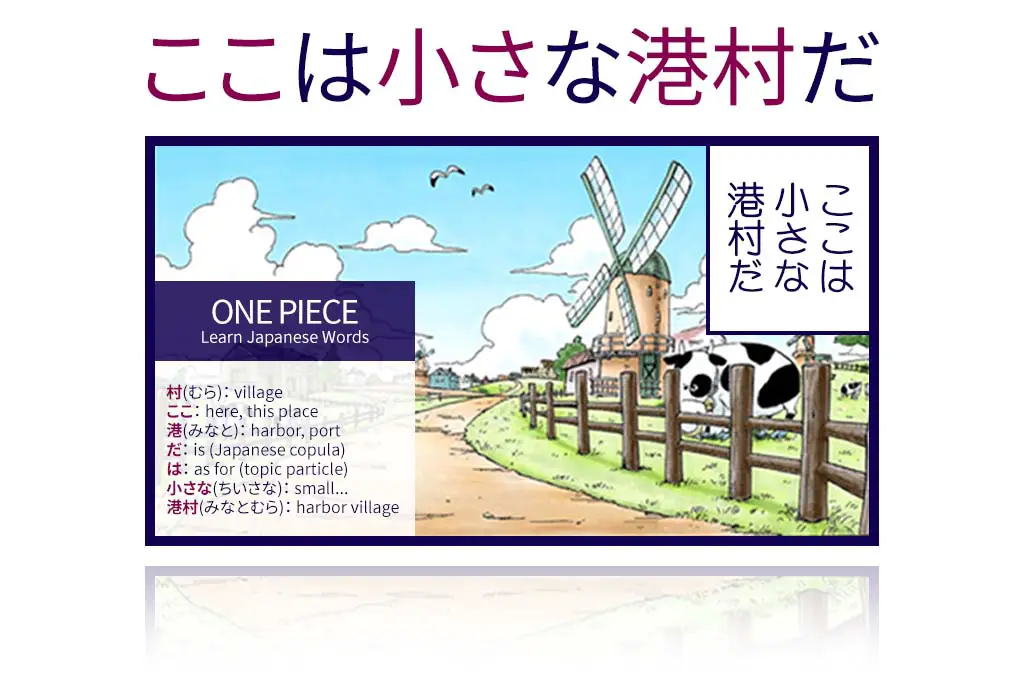
ここ (此処): Here, This Place
Type: pronoun
Meaning: “Here” or “this place”.
Usage: ここ refers to the location being discussed or talked about. It indicates the speaker’s current position or the surrounding area the speaker is talking about.
| ここ 此処 |
| here, this place |
Advanced Notes: It’s part of the ko-so-a-do set of words. ここ (here), そこ (there), あそこ (over there), どこ (where).
は (wa): Topic Particle “As for…”
Type: particle (grammar)
Function: “Topic marker” or “topic particle”.
Usage: は marks the preceding word (in our case “ここ”) as the topic of the sentence. It implies that the part that follows will provide information about this topic.
| は |
| topic particle (as for…) |
Beginner Notes: The particle は is written with the hiragana syllable “ha”, but always pronounced “wa” when used as a topic marker. To make this as clear as possible and to avoid mistakes whenever possible I write it as “ha (wa)” in romaji which is not the standard way of doing it.
Tip: Learn hiragana (and katakana) as soon as possible to avoid confusion.
小さな (ちいさな): Small
Type: pre-noun adjectival
Meaning: “Small” or “little”.
Components: 小さ + な
Usage: 小さな is an adjective used to directly describe the noun that follows (in this case “港村”). The “な” (na) after “小さ” is a particle that is necessary to connect it to the noun.
| 小さな ちいさな |
| small…, little… |
Beginner Notes: The Japanese language has two adjective types: Na-adjectives and i-adjectives. 小さな is similar to a na-adjective but only used directly before a noun.
Advanced Notes ①: While 小さな behaves like a typical na-adjective, it is actually a special type of adjective called “pre-noun adjectival”. So you can say 小さな港村 (like a na-adjective), but you cannot say 港村が小さな. Instead, you would use 港村が小さい (i-adjective). So, while it functions similarly to a na-adjective in some contexts, it’s classified differently and has distinct usage rules.
Advanced Notes ②: The particle “な” after the noun is actually just another form of the Japanese copula “だ”. It’s like a conjugation or inflection.
港村 (みなとむら): Harbor Village
Type: compound noun
Meaning: “Harbor village” or “port village”.
Components:
港 (みなと): “harbor” or “port”
村 (むら): “village”
Usage: 港村 is the place that is talked about and the noun described by “小さな”. It consists of two separate kanji and words “港 (harbor, port)” and “村 (village)”.
| 港村 みなとむら |
| harbor village, port village |
だ: Japanese Copula (=, is)
Type: auxiliary verb (grammar)
Function: “Copula” or “=” (similar to “is” in English).
Usage: だ asserts a state of being, and you can think of it like an equals sign (A = B). It indicates that A (in our case an omitted subject) is B (in our case “港村”).
| だ |
| Japanese copula (=, is) |
Additional Note: だ is the casual form of です. だ is often referred to as the “casual copula”, です is called the “polite copula”. They have the same meaning, but です is more formal than だ and makes your sentence sound more polite.
Romaji
check if necessary
ここ (koko): here, this place
は (ha/wa): as for (topic particle)
小さな (ちいさな, chiisa na): small…
港村 (みなとむら, minato mura): harbor village
だ (da): is (Japanese copula)
Learn Hiragana:
だ: da
こ: ko
は: ha
ち: chi
い: i
さ: sa
な: na
み: mi
と: to
む: mu
ら: ra
3. Master Japanese Sentence Structure & Grammar
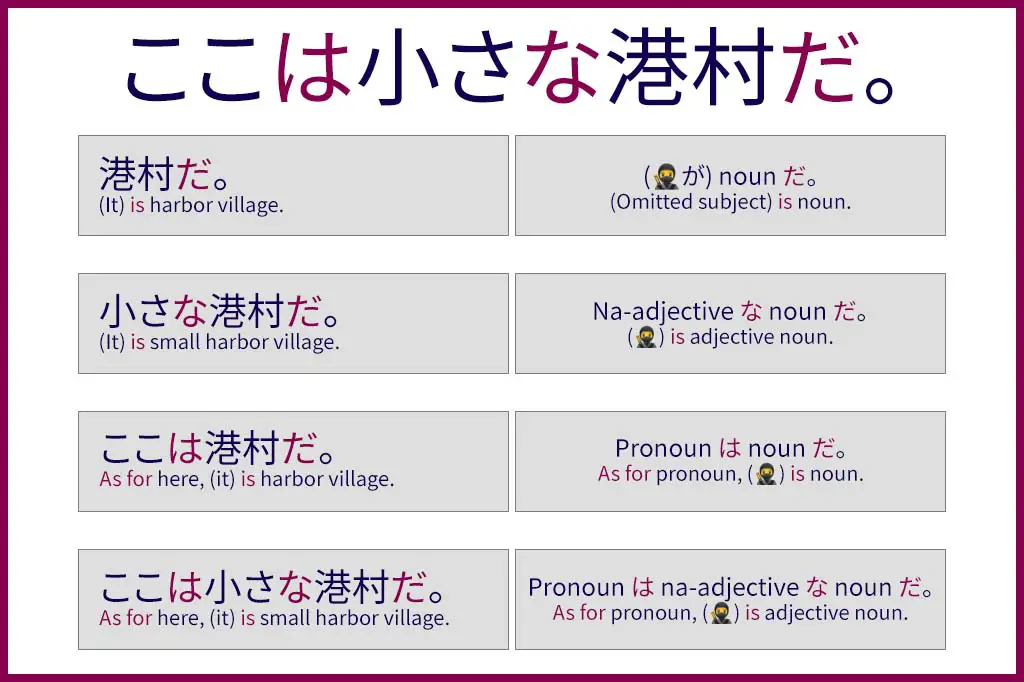
Japanese Core Sentences
| 港村だ。 みなとむら だ。 (It) is harbor village. |
Every Japanese sentence can be broken down into one of the 3 Japanese core sentences.
In our One Piece example, the Japanese core sentence is “港村だ” which says that “A is B”.
A is B.
(Aが)Bだ。
(Subject-A が) Noun-B だ。
However, as so often in Japanese our subject (Aが) is omitted, so all we have is the latter part “Bだ”.
A is B.
(Aが)港村だ。
Noun-B: 港村 (みなとむら)
As long as you think in Japanese it is not confusing because it means that something you already know from context (A) is or equals our noun 港村 (B). “A = B” or “A = 港村“.
However, when translating it into English, you need to include a subject, which is where it gets tricky. You’re translating something that isn’t explicitly stated into a concrete English word. It’s like trying to name an invisible ninja (🥷が).
In our example sentence, the omitted subject can be translated as “it“. To clarify in my translation that it’s an omitted subject, I always write our invisible ninja subject (🥷が) in parentheses “(It) is harbor village.“
Also, please note that there are no articles (a, an, the) in the Japanese language. To stay closer to the original Japanese sentence structure I omit articles and translate 港村 as “harbor village” instead of “a harbor village” or “the harbor village” in this section of the blog post.
Ready for a quick quiz? Let’s try!
海賊 (かいぞく) means “pirate“.
How can you translate “海賊だ。”?
Answer
海賊だ。
かいぞく だ。
(It) is pirate.
Using Na-Adjectives Before Nouns
| 小さな港村 ちいさ な みなとむら small harbor village |
Na-adjectives are words that describe or modify nouns, providing more information about them. Like in English, they typically come before the nouns they describe or modify.
However, na-adjectives require the particle “な” to connect to the noun they modify.
adjective noun
(e.g. small harbor village)
na-adjective + な + noun
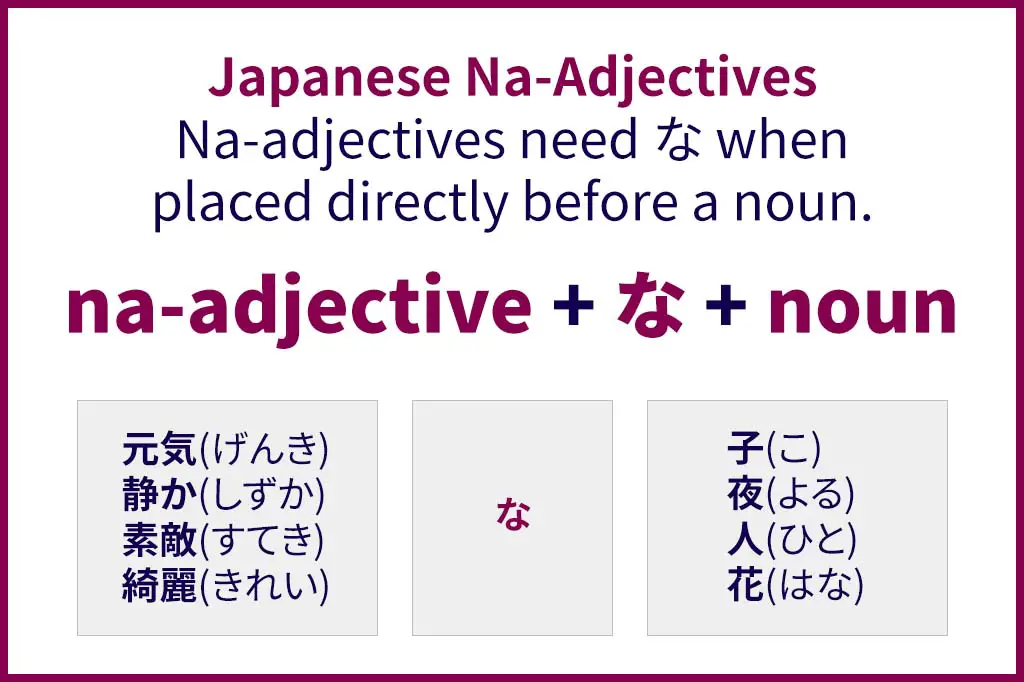
In our example from the One Piece manga, we have the noun 港村 (みなとむら) and the na-adjective 小さな (ちいさな). Since it already has the な attached to it you just have to put them in the right order to say “small harbor village“.
小さな港村
ちいさな みなとむら
small harbor village
Ready for a quick quiz? Let’s try!
綺麗 (きれい) means “beautiful“.
How do you say “beautiful harbor village“?
Answer
綺麗な港村
きれい な みなとむら
Did you get it right? If not, no worries! We’ll practice more later!
With the knowledge about na-adjectives, you now understand a slightly longer version of our core sentence (Aが)Bだ. Just add a na-adjective before our Noun-B and voila you get the following sentence.
| 小さな港村だ。 ちいさ な みなとむら だ。 (It) is small harbor village. |
Dare to try creating the following sentences?
Ready for a quick quiz? Let’s try!
“It’s a beautiful harbor village”
Answer
綺麗な港村だ。
きれい な みなとむら だ。
(It) is beautiful harbor village.
Basic Sentences with Topic Marker は
| ここは ここ は as for here/this place |
The topic marker or topic particle は (pronounced “wa”) marks the topic of a Japanese sentence. It introduces what the sentence is about and what the speaker wants to focus on. While the topic can overlap with the subject, it doesn’t have to.
When you add a topic to our Japanese core sentence, you get one of the most common Japanese sentence structures.
X, (A) is B.
Xは(Aが)Bだ。
Topic-X は (Subject-A が) Noun-B だ。
| ここは港村だ ここ は みなとむら だ As for here, (it) is harbor village. |
Many beginners often encounter confusion here. Even those who have been studying Japanese for years have trouble telling the difference between the topic particle は and the subject particle が. The main reason for this confusion is that the topic often becomes the subject when translated into natural English.
Take our One Piece sentence (“ここは小さな港村だ”), for example. In natural English, this becomes “This is a small harbor village” or “Here is a small harbor village“, making ここ look like the subject.
However, in the actual Japanese sentence, the subject is omitted. It’s our hidden ninja subject (🥷が). This only becomes clear in a more literal translation, though: “As for here, (here/this place/it) is small harbor village“.
Japanese Sentence Structure:
X, (A) is B.
Xは(Aが)Bだ。
Topic-X は (Subject-A が) Noun-B だ。
“As for Topic-X, (Subject-A) is Noun-B.”
Natural English Translation:
X is B.
XはBだ。
Topic-X は Noun-B だ。
“Topic-X is Noun-B.”
So the key takeaway is that, when translating Japanese into English, the topic (marked by は) often becomes the subject. However, in the Japanese sentence itself, the topic is never the subject. The subject is always marked by が, but it is often omitted (a hidden ninja 🥷が).
To avoid confusion, I translate は as “as for (topic)” and include the omitted subject in parentheses.
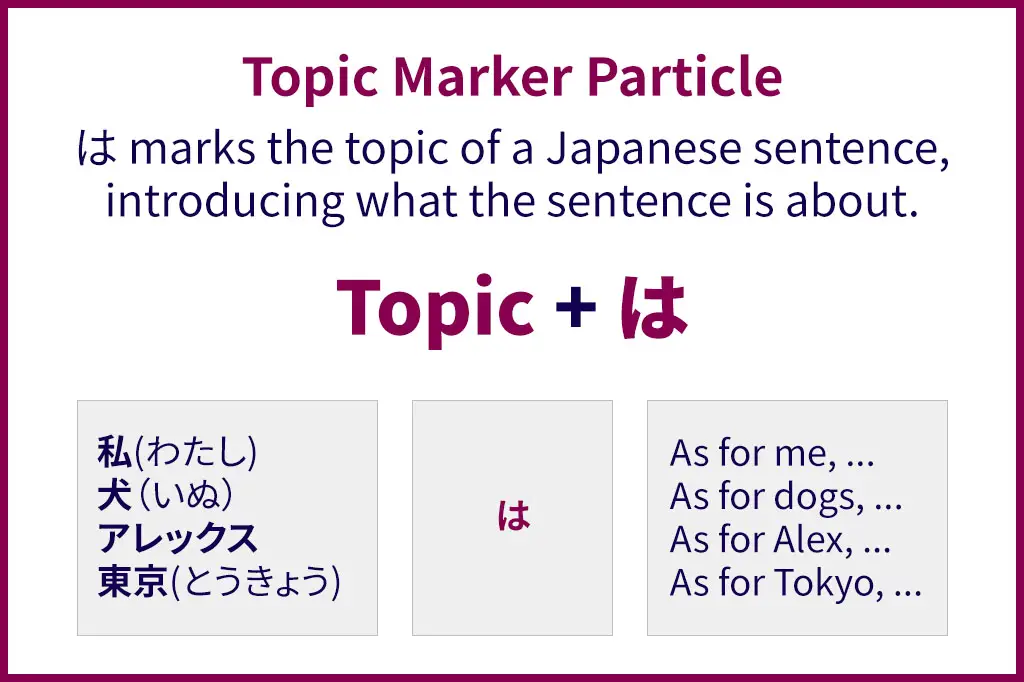
Now, all we need to do is add our descriptive na-adjective (小さな) before our noun (港村) to get the complete sentence from the One Piece manga.
| ここは小さな港村だ ここ は ちいさ な みなとむら だ As for here, (it) is small harbor village. |
Ready for a quick quiz? Let’s try!
ルフィ is the Japanese name for “Luffy“.
海賊 (かいぞく) means “pirate“.
How can you translate “ルフィは海賊だ。“
Answer
ルフィは海賊だ。
ルフィ は かいぞく だ。
As for Luffy, (he) is pirate.
Natural English: Luffy is a pirate.
4. Final Reading Challenge
- 港村だ。
- ここは港だ。
- 小さな村だ。
- ここは小さな港村だ。
If you want to review today’s words, practice your reading skills further, and start speaking Japanese right now, check out my Japanese Reading Practice: One Piece #1 quiz post!
